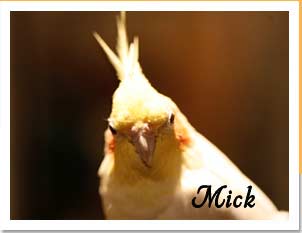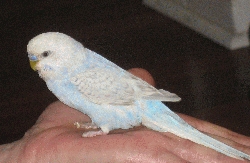Building an Aviary for Rescued King Pigeons
By Elizabeth Young
King pigeons are big, gorgeous, snow white, gentle birds that mate for life and coo softly to each other. They are bred for meat (squab) and most are killed as babies at the age of 4 weeks (to be tender, like veal) but a few escape or are set "free". They are domestic birds unable to find food or fly well enough to evade predators. Unless they are given a home, they die. They don't survive in the wild. There is no "free" for king pigeons so keeping them in an aviary is not cruel, it is life-saving.
I met a king pigeon scheduled to be euthanized (for lack of an adopter) in an animal shelter in 2007 and after finding her a home, created MickaCoo Pigeon and Dove Rescue. Since then, we've placed more than 300 in wonderful homes but we're always full up with birds in foster care. We need more adopters! It is easy to create a beautiful, charming and life-saving aviary for these birds. We would love to help you to provide a home for these rescued innocents. |
King pigeons are calm and good-natured and they excel at the leisure arts. They can live very happily year-round in an outdoor aviary (no heating or cooling required in most locales). It needs to be predator-proof (sturdy and securely built), rodent-proof (use mesh with openings no more than half an inch), and include a sheltered corner and back area that will provide enough deep shade for all in the hottest weather and protection from blowing rain in the winter. They require about 20 minutes of daily care with a weekly aviary cleaning (figure an hour). They are quiet and peaceful and, with time and attention, most can be hand-tamed.
It's easy to create a charming, attractive and safe aviary for rescued king pigeons.
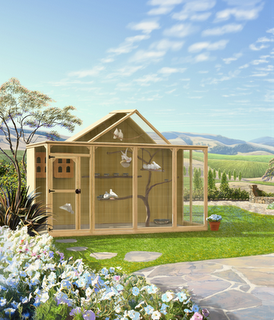
SIZE
Build it as large as your space and budget allow. No one has ever wished for a smaller aviary. Because king pigeons can't be free-flown, they will spend all their time inside the aviary. Space is one of the greatest gifts you can give to a captive bird. For your own convenience, you'll want something big enough to walk into (easier to maintain) but, if you really want to enjoy your birds, build it large enough so that you can sit down on a chair or a bench inside the aviary and be a member of the flock. The minimum size that I recommend is 7' long by 4' wide by 6' high for 4 king pigeons. An aviary 12' long by 6' wide by 6' tall or more will house about 10 pigeons and you and your birds will have a lot more fun.
DESIGN
Horizontal space is most important. Even birds that can't fly well enough to survive in the wild like to stretch their wings and fly a bit so design your aviary to be as long as possible. I recommend a minimum length of 7' (longer is better) and rectangular shaped-aviaries offer maximum opportunity to fly a few wingbeats. Round or hexagonal shapes, while pleasing to look at, have to be very large to offer the same opportunity. Pigeons are ground feeders and will forage (and strut and flirt and bathe and socialize) on the ground but they also will fly to and perch in the middle and upper reaches. I recommend a peaked or sloped roof to prevent rain from pooling on top and because the birds will enjoy roosting up in the "attic". Leave at least some of the roof as mesh rather than solid to let in sunshine, rain, moonlight and air circulation.
LOCATION When locating your aviary, I suggest choosing the site that offers you the best view of it while also balancing the needs of the birds and your neighbors too. Pigeons are quiet but they do coo and so you'll want to consider the sounds they make when locating the aviary. Pigeons have poor low-light vision so a bright location is preferable. They enjoy sunshine as well as rain and so I like aviaries that get both. (It is important that their nest boxes stay dry.) |
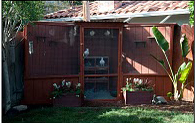
FOUNDATION/GROUND COVER
An aviary can be built onto a cement pad, pavers, a wooden floor or on earth. It should be easy to keep clean, provide good drainage, and protect against rodents and predators that will try to dig or chew their way in. Unless the floor is cement, the entire bottom of the aviary should be lined with hardware mesh (half inch openings or less) to keep rodents and predators out. The mesh should be covered by wood, earth or drain rock as standing on wire is harmful to their feet.
My backyard aviary is a converted patio and so the bottom is cement. That's fine for the birds but it would be easier for me to maintain if it was drain rock. With cement (or wood or tile), the bottom needs a daily poop scraping. If your aviary floor is covered with a few inches of drain rock (3/4" or larger, also called "washed rock"), then it only needs occasional raking and/or hosing for maintenance. The drain rock is fine for the birds' feet, is clean (no mud) and acts as a natural filter for waste. (Pea gravel is sometimes used but it isn't recommended because some birds will over-indulge their desire for grit and eat too many pebbles.)
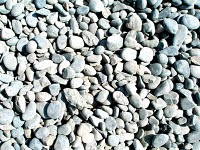 |
CONSTRUCTION
An aviary must be rodent and predator-proof and even the most urban or suburban of neighborhoods have at minimum cats, birds of prey, rats and raccoons that will have to be kept out. (Some environments have lots more wildlife to guard against.) The aviary needs to be built sturdily. Raccoons are incredibly strong and tenacious and, if they locate a weak spot in the design, they will work on it night after night until they get in. On the other hand, if the aviary is well-built, predators will stop testing it and leave your birds to live in peace. And your aviary needs to be sealed completely with wildlife-proof mesh with openings .5" or smaller. The size (and strength) of the mesh is important. If the openings are bigger, you'll attract mice and put your birds within claw's reach of all sorts of animals. Online searches of aviaries will show pictures of aviaries made with chickenwire or chain link but they don't show the carnage that predators cause by reaching through those too-big openings and tearing birds apart while still "safely" inside. Also, mesh openings bigger than half an inch is inviting every mouse in the world (plus any petite rats) to move in make themselves at home forever. It's much easier to build the aviary rodent and predator-proof than it is to go back and patch one that wasn't.
WEATHER and SHELTER
I live in San Francisco and MickaCoo volunteers have foster aviaries throughout the Bay Area. Our weather is mild. The pigeons' aviaries need to provide a sheltered corner that offers access to deep shade (to guard against overheating) and protection from driving winter rains. They love the rain and not all of it needs to be kept out but their nest boxes must stay dry. Depending on where you live, you may need to provide extra protection from weather conditions. MickaCoo does ship pigeons to long-distance approved adopters throughout the Continental US and we have rescued king pigeons living very happily with adopters in AZ, CO, OH, IN, GA, TN, WI, CT and NY (so far).
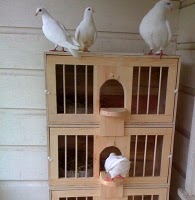 |
NEST BOXES Your king pigeon aviary will need nest boxes. These are for nesting and being cozy rather than nesting to breed babies. MickaCoo does not support breeding because there are "surplus" pigeons being euthanized every day for lack of homes. Nest boxes are provided because pigeons are cavity nesters and they love and need a cubby-hole type nest area. A nest box can be as simple as a basket or wooden box. Nest boxes can be purchased ready made or built along with the aviary. When pigeons become mature (between 4 and 6 months of age), they court, choose a mate and select a nest box in which they'll build a loosely constructed nest. The hen will lay a pair of eggs and the couple will take turns sitting on them. We provide fake eggs which are substituted for the real eggs (for pigeon birth control). |
PERCHES
Pigeons don't climb like parrots do (and they're fine with galvanized wire). They need open space to jump or fly up and down from perches. They also really enjoy shelves to lounge on. Situating perches near the aviary's mesh walls will give the birds an easy view out and allow you a close look at their beauty and personality. I recommend using natural branches (approximately 1-2" diameter) because their size usually varies from tip to trunk and it is good for bird to be able to vary the grip of their feet.
FOOD and WATER
Pigeons love water and will need fresh, clean water every day for drinking and for bathing. I use clear, plastic containers because I love to watch their happy pink bathing feet dancing in the water but you can use ceramic casserole dishes or large plant saucers. The water should be between 2-4" deep and changed daily. It's best to provide two water sources and I recommend getting duplicates of whatever containers you use so that one set can be cleaned and dried while the other is being used. Pigeons are ground foragers and their food dishes should be on the ground. I recommend one dinner-plate size dish (with ~1 cup of pigeon feed) for every four pigeons each day. Feed can be purchased at feed stores and is a mix of different types of peas, corn, oats, safflower, milo and other grains. It can be stored in a rodent-proof, moisture-proof container. An extra treat of a planter of lettuces or parsley or dandelion greens or spinach or wheat grass will be appreciated. Whatever type container you use, make it something non-toxic.
MIRRORS
Pigeons have been proven to self-recognize in mirrors (along with elephants, dolphins and chimpanzees) and they enjoy them very much. I think they use them like we use TV. We know TV isn't real but we still get emotionally engaged in what we see and are entertained by the experience. I recommend securing a full-length mirror horizontal to the ground and enjoying the show.
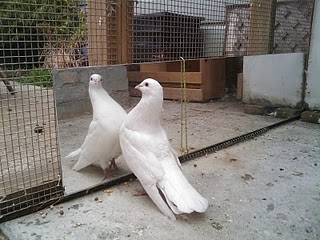
MAINTENANCE
The birds need clean food and water dishes every day. Once a week, a poop scrape of flat surfaces and hose-down will keep your aviary clean and your birds happy. I use a paint scraper and a dust bin. (The poop is world class for composting.) Keeping your aviary uncrowded will help keep it clean and healthy too.
MISCELLANEOUS
King pigeons are calm and easy going. You don't need a double-door to keep them from flying out (but do be conscientious about keeping the aviary door closed). You can mow your lawn, blow your leaves, play with your dog and let your cats hang out in the yard- all without frightening king pigeons. They understand the difference between inside and out and they don't worry about what goes on outside the aviary. You can also be creative. It's easy to repurpose a shed or play gym into a wonderful aviary. And, if you'd rather rescue doves or homers or rollers, you can still use this same design to create your aviary. Doves, homers and rollers are smaller and so you can scale down the size of perches and nest boxes but they're better and more active flyers so they'll appreciate the fly space. And you don't need a "trap" (the door that free-flying pigeons use to exit and enter a pigeon loft) because rescued pigeons and doves can't be safely free-flown. That's why they need you to create them a lovely, charming and life-saving aviary.
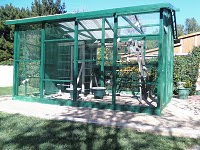
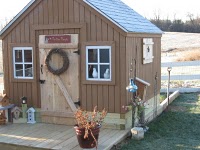
RECOMMENDED LINKS and RESOURCES
Pigeon Talk at www.pigeons.biz/forums
MickaCoo Pigeon and Dove Rescue at www.MickaCoo.org
Nyla Copp, N. Cal Aviary Builder at www.MyBirdieBuddy.com
Wes Askins at www.BestCoops.com
Until there are homes for all, don't buy, don't breed- adopt!
